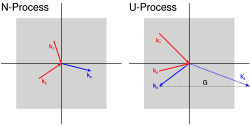Umklapp scattering


Umklapp scattering (also U-process or Umklapp process) is the transformation, like a reflection or a translation, of a wave vector to another Brillouin zone as a result of a scattering process, for example an electron-lattice potential scattering or an anharmonic phonon-phonon (or electron-phonon) scattering process, reflecting an electronic state or creating a phonon with a momentum k-vector outside the first Brillouin zone. Umklapp scattering is one process limiting the thermal conductivity in crystalline materials, the others being phonon scattering on crystal defects and at the surface of the sample.
Figure 1 schematically shows the possible scattering processes of two incoming phonons with wave-vectors (k-vectors) k1 and k2 (red) creating one outgoing phonon with a wave vector k3 (blue). As long as the sum of k1 and k2 stay inside the first Brillouin zone (grey squares) k3 is the sum of the former two conserving phonon momentum. This process is called normal scattering (N-process).
With increasing phonon momentum and thus wave vector of k1 and k2 their sum might point outside the Brillouin zone (k'3). As shown in Figure 2, k-vectors outside the first Brillouin zone are physically equivalent to vectors inside it and can be mathematically transformed into each other by the addition of a reciprocal lattice vector G. These processes are called Umklapp scattering and change the total phonon momentum.
Umklapp scattering is the dominant process for thermal resistivity at high temperatures for low defect crystals. The thermal conductivity for an insulating crystal where the U-processes are dominant has 1/T dependence.
The name derives from the German word umklappen (to turn over). Rudolf Peierls, in his autobiography Bird of Passage states he was the originator of this phrase and coined it during his 1929 crystal lattice studies under the tutelage of Wolfgang Pauli. Peierls wrote, "...I used the German term Umklapp (flip-over) and this rather ugly word has remained in use....[1]"